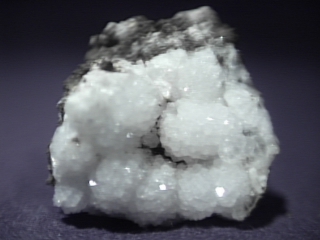
PHILLIPSITE
Specimen phi-3
$ 25.00
Dims: 3.1 x 2.6 x 1.7" (7.9 x 6.6 x 4.3 cm)
Wt: 5.35 oz. (151.6 g)
Horseshoe Dam, Maricopa County, Arizona, U.S.A.
Scores of tiny Phillipsite crystals rest in vugs in the igneous host rock of this speciemen. They are extremely small, not exceeding 0.1" (3 mm) along any axis, and are in excellent condition, due to the protection provided by the hollows in which they rest. They are difficult to study even with a 10-power loupe, but appear to occur either in tiny, rounded compact sprays or as druses of tiny crystals. The more exposed rounded sprays have a cream coloration, whereas the druses have a much cleaner white color. The dull brown host rock on which they rest is very rough and heavily pitted with hollows, most of which contain Phillipsite.







